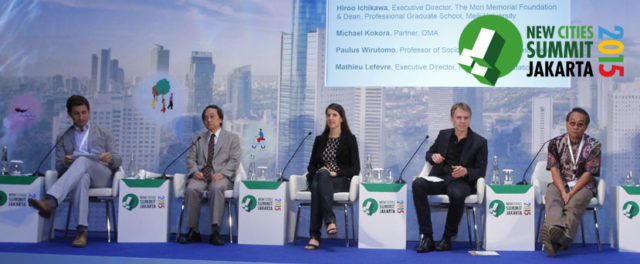Divercity: Difference as an Urban Asset
août 28, 2015 — Uncategorized
This post is part of our Seizing the Urban Moment discussion series, following the fourth edition of the New Cities Summit in Jakarta in June 2015.

“How can diversity be an asset?” asked our Executive Director, Mathieu Lefevre at the start of this discussion at the New Cities Summit.
Cities attract people from diverse communities who come in search of opportunities. It is therefore crucial to understand the concept better. However, since cities do not become diverse in a systematic way, diversity remains a difficult concept to grasp. Each speaker offered a different approach to the issue, bringing in examples particular to his or her city.
Hiroo Ichikawa of Japan’s Mori Memorial Foundation argued that a diverse city appeals to the human senses. He presented diversity among six key elements of an “intangible environment”, the others being efficiency, change and growth, accuracy and speed, hospitality, and safety and security. When ranking cities according to their performance in these areas, Tokyo comes first, followed by Vienna. However, Ichikawa also stated that if we had to look at diversity only, Paris would be today’s top city. By contrast, Tokyo struggles with homogeneity and would not rank high. If the Japanese started thinking more about how to integrate foreigners in Tokyo, the city would reach a higher degree of competitiveness, he concluded.
Coming from the heart of the Silicon Valley, Rose Broome, CEO and Co-Founder of HandUp, provided insights into the impact of people moving to San Francisco to work at tech companies. This has led to an increase in housing prices, which have now become the highest in the United States, and the displacement of local communities who cannot afford living costs. Diversity in this context has created a backlash, and conversations about the need to build technology serving the local diverse communities. She mentioned the “need to start thinking as big about diversity and poverty as we do about driving cars and artificial intelligence”.
OMA’s Michael Kokora then shared his personal experience growing up in a mono-cultural environment where you had five types of houses only, and where everyone was white and middle class. He soon felt like running away from his xenophobic cocoon, and as an architect, became obsessed with giving a public space component to the buildings he designed for the unexpected to happen. Looking at Jakarta, he found the variety of spatial typologies fascinating.
Meanwhile, Indonesia University’s Paulus Wirutomo was quick to point out that diversity in Jakarta is not well managed. He pointed towards an “objective exclusion” as the government fails to accommodate citizen participation in development initiatives, and also a subjective one, as people themselves exclude themselves from society. Finally, he suggested that by improving the physical infrastructure within slums, this would reduce the amount of young men who join violent gangs that form the counterculture.
Speakers
Hiroo Ichikawa, Executive Director, The Mori Memorial Foundation & Dean, Professional Graduate School, Meiji University
Rose Broome, Founder, HandUp – @rosical
Michael Kokora, Partner, OMA
Paulus Wirutomo, Professor of Sociology, University of Indonesia
Moderator: Mathieu Lefevre, Executive Director, NewCities – @newcitiesfound